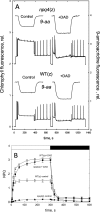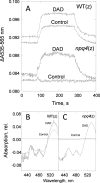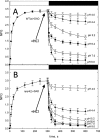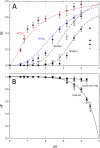Restoration of rapidly reversible photoprotective energy dissipation in the absence of PsbS protein by enhanced DeltapH
- PMID: 21474447
- PMCID: PMC3103371
- DOI: 10.1074/jbc.M111.237255
Restoration of rapidly reversible photoprotective energy dissipation in the absence of PsbS protein by enhanced DeltapH
Abstract
Variations in the light environment require higher plants to regulate the light harvesting process. Under high light a mechanism known as non-photochemical quenching (NPQ) is triggered to dissipate excess absorbed light energy within the photosystem II (PSII) antenna as heat, preventing photodamage to the reaction center. The major component of NPQ, known as qE, is rapidly reversible in the dark and dependent upon the transmembrane proton gradient (ΔpH), formed as a result of photosynthetic electron transport. Using diaminodurene and phenazine metasulfate, mediators of cyclic electron flow around photosystem I, to enhance ΔpH, it is demonstrated that rapidly reversible qE-type quenching can be observed in intact chloroplasts from Arabidopsis plants lacking the PsbS protein, previously believed to be indispensible for the process. The qE in chloroplasts lacking PsbS significantly quenched the level of fluorescence when all PSII reaction centers were in the open state (F(o) state), protected PSII reaction centers from photoinhibition, was modulated by zeaxanthin and was accompanied by the qE-typical absorption spectral changes, known as ΔA(535). Titrations of the ΔpH dependence of qE in the absence of PsbS reveal that this protein affects the cooperativity and sensitivity of the photoprotective process to protons. The roles of PsbS and zeaxanthin are discussed in light of their involvement in the control of the proton-antenna association constant, pK, via regulation of the interconnected phenomena of PSII antenna reorganization/aggregation and hydrophobicity.
Figures







Similar articles
-
Elevated ΔpH restores rapidly reversible photoprotective energy dissipation in Arabidopsis chloroplasts deficient in lutein and xanthophyll cycle activity.Planta. 2012 Jan;235(1):193-204. doi: 10.1007/s00425-011-1502-0. Epub 2011 Aug 25. Planta. 2012. PMID: 21866345
-
Arabidopsis plants lacking PsbS protein possess photoprotective energy dissipation.Plant J. 2010 Jan;61(2):283-9. doi: 10.1111/j.1365-313X.2009.04051.x. Epub 2009 Oct 16. Plant J. 2010. PMID: 19843315
-
The xanthophyll cycle affects reversible interactions between PsbS and light-harvesting complex II to control non-photochemical quenching.Nat Plants. 2017 Jan 30;3:16225. doi: 10.1038/nplants.2016.225. Nat Plants. 2017. PMID: 28134919
-
The photoprotective molecular switch in the photosystem II antenna.Biochim Biophys Acta. 2012 Jan;1817(1):167-81. doi: 10.1016/j.bbabio.2011.04.007. Epub 2011 May 1. Biochim Biophys Acta. 2012. PMID: 21569757 Review.
-
Energy-Dependent Non-Photochemical Quenching: PsbS, LhcSR, and Other Players.Biochemistry (Mosc). 2025 Jan;90(1):44-60. doi: 10.1134/S000629792460371X. Biochemistry (Mosc). 2025. PMID: 40058973 Review.
Cited by
-
Three pools of zeaxanthin in Quercus coccifera leaves during light transitions with different roles in rapidly reversible photoprotective energy dissipation and photoprotection.J Exp Bot. 2013 Apr;64(6):1649-61. doi: 10.1093/jxb/ert024. Epub 2013 Feb 6. J Exp Bot. 2013. PMID: 23390289 Free PMC article.
-
A Comparison of Photoprotective Mechanism in Different Light-Demanding Plants Under Dynamic Light Conditions.Front Plant Sci. 2022 Apr 6;13:819843. doi: 10.3389/fpls.2022.819843. eCollection 2022. Front Plant Sci. 2022. PMID: 35463455 Free PMC article.
-
Protection of photosystem I during sudden light stress depends on ferredoxin:NADP(H) reductase abundance and interactions.Plant Physiol. 2022 Feb 4;188(2):1028-1042. doi: 10.1093/plphys/kiab550. Plant Physiol. 2022. PMID: 35060611 Free PMC article.
-
Understanding the roles of the thylakoid lumen in photosynthesis regulation.Front Plant Sci. 2013 Oct 31;4:434. doi: 10.3389/fpls.2013.00434. Front Plant Sci. 2013. PMID: 24198822 Free PMC article. Review.
-
The combined effect of Cd and high light stress on the photochemical processes in Arabidopsis thaliana.Photosynthetica. 2025 Jul 8;63(2):182-195. doi: 10.32615/ps.2025.020. eCollection 2025. Photosynthetica. 2025. PMID: 40766736 Free PMC article.
References
-
- Horton P., Ruban A. V., Walters R. G. (1996) Annu. Rev. Plant Physiol. Plant Mol. Biol. 47, 655–684 - PubMed
-
- Holt N. E., Fleming G. R., Niyogi K. K. (2004) Biochemistry 43, 8281–8289 - PubMed
-
- Nelson N., Ben-Shem A. (2004) Nat. Rev. Mol. Cell Biol. 5, 971–982 - PubMed
-
- Kramer D. M., Avenson T. J., Edwards G. E. (2004) Trends Plant Sci. 9, 349–357 - PubMed
-
- Arnon D. I., Allen M. B., Whatley F. R. (1954) Nature 174, 394–396 - PubMed
Publication types
MeSH terms
Substances
Grants and funding
LinkOut - more resources
Full Text Sources
Molecular Biology Databases

